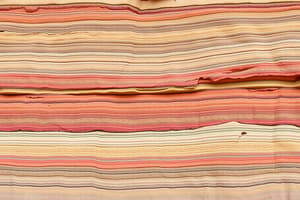Podcast
Questions and Answers
What principle states that all rock layers were originally deposited horizontally?
What principle states that all rock layers were originally deposited horizontally?
- Principle of Superposition
- Principle of Original Horizontality (correct)
- Principle of Cross-Cutting Relationships
- Principle of Inclusions
Which principle indicates that the layers of rock above are younger than those below?
Which principle indicates that the layers of rock above are younger than those below?
- Principle of Inclusions
- Principle of Cross-Cutting Relationships
- Principle of Superposition (correct)
- Principle of Fossil Succession
What describes the process by which rocks are determined to be older based on what they contain?
What describes the process by which rocks are determined to be older based on what they contain?
- Relative Dating
- Principle of Inclusions (correct)
- Absolute Dating
- Principle of Fossil Succession
Which method is used to determine the numerical age of rocks?
Which method is used to determine the numerical age of rocks?
Which principle claims that an igneous intrusion is always younger than the rock it cuts across?
Which principle claims that an igneous intrusion is always younger than the rock it cuts across?
What often provides evidence for the relative ages of rocks and the history of life on Earth?
What often provides evidence for the relative ages of rocks and the history of life on Earth?
What are sediments called when they contain older rocks mixed within their layers?
What are sediments called when they contain older rocks mixed within their layers?
What is the significance of fossils within sedimentary layers?
What is the significance of fossils within sedimentary layers?
What is the primary basis of stratigraphy as a dating method?
What is the primary basis of stratigraphy as a dating method?
Which of the following techniques uses the decay of radioactive isotopes to determine age?
Which of the following techniques uses the decay of radioactive isotopes to determine age?
Which dating method relies on comparing fossils from different strata?
Which dating method relies on comparing fossils from different strata?
What does dendrochronology use to determine the age of trees?
What does dendrochronology use to determine the age of trees?
In absolute dating, what is primarily measured to determine age?
In absolute dating, what is primarily measured to determine age?
Which method is used to determine age based on the last period an object absorbed light?
Which method is used to determine age based on the last period an object absorbed light?
What is a key difference between relative dating and absolute dating?
What is a key difference between relative dating and absolute dating?
Which dating method utilizes the protein content of biological samples?
Which dating method utilizes the protein content of biological samples?
Flashcards are hidden until you start studying
Study Notes
Stratified Rocks
- Form due to the deposition of materials like sand and silt, creating layers on top of each other.
- Common examples include riverbeds.
Relative Dating
- Determines the age of rocks by identifying the order of past events.
- Relies on fossils to establish a timeline.
- Stratigraphy is a technique that assumes the lowest layer is the oldest and the topmost is the youngest.
- Biostratigraphy uses faunal deposits and fossils to establish dating strategies, extending on stratigraphy techniques.
- Cross Dating compares fossils in different layers to determine their relative ages.
Absolute Dating
- Determines the numerical age of rocks using various methods.
- Radiometric dating measures the amount of a specific radioactive isotope in a sample to determine its age.
- Amino acid dating relies on the changes in protein content of biological samples over time.
- Dendrochronology uses the annual growth rings of dicot trees to estimate their age.
- Thermoluminescence determines the age of an object by measuring the last time it absorbed light and emitted electrons.
Principles of Relative Dating
- Principle of Original Horizontality: All rock layers were originally deposited horizontally.
- Principle of Superposition: Each layer of sediment or rock is piled on top of another, making the top layer the youngest and the bottom layer the oldest.
- Principle of Cross-Cutting Relationships: An igneous intrusion is always younger than the rock it cuts across.
- Principle of Inclusions: Rocks embedded within sediments are older than the sediment layer itself.
- Principle of Fossil Succession: Different fossils appear in specific geologic time periods, allowing scientists to date rock layers based on the fossils they contain.
Relative vs. Absolute Dating
- Relative dating focuses on the physical relationships between rocks to establish a timeline.
- Absolute dating uses measurements to determine the numerical age of rocks.
Studying That Suits You
Use AI to generate personalized quizzes and flashcards to suit your learning preferences.




